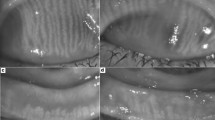Abstract
Aim
To examine ocular surface changes in patients with maturity-onset diabetes of young (MODY).
Material and methods
Fifty patients with MODY who were transferred to Genetic Diagnosis Department of Diskapi Yildirim Beyazit Training and Research Hospital have been included. All patients were subjected to Ocular Surface Illness Index (OSDI) survey, shirmer test, invasive and non-invasive tear break up time (TBUT), cornea fluorescein, and Lissamine green dye tests. Lastly, meibography measurements have been completed using Sirius Scheimpflug camera (Sirius, CSO, Florence, Italy).
Results
All 50 patients had a glucokinase (GCK) mutation. MODY diagnosis time was 5.0 ± 5.5 years (range: 0–20 years) on an average. While the average HBa1c levels were 5.5 (range: 4.8–6.5, reference range: 4–6), none of the patients were diagnosed with diabetic retinopathy in fundus examination. There was no significant difference between MODY and control group in terms of OSDI score, Schirmer 1 test, meibomian gland loss, average BUT, TBUT ((p)0.05).
Discussion
Our work is the first one which specifically evaluates ocular surface in MODY patients. Contrary to the common concept that “dry eye is frequently seen in type 1 and type 2 DM,” we did not come across any significant difference between MODY and control group in ocular surface tests. It might be linked to the fact that not enough time had passed for DR or DES symptoms to be detected. Our patients’ average diabetes diagnosis length might be a short time span for clinical symptoms like DR and DES to show up.
Similar content being viewed by others
References
Caffery BE, Richter D, Simpson T, Fonn D, Doughty M, Gordon K. The Canadian dry eye epidemiology study. Adv Exp Med Biol. 1998;438:805–6.
Seifart U, Strempel I. The dry eye and diabetes mellitus. Ophthalmologe. 1994;91:235–9.
Jin J, Chen LH, Liu XL, Jin GS, Lou SX, Fang FN. Tear film function in non insulin dependent diabetics. Zhonghua Yan Ke Za Zhi. 2003;39:10–3.
Akinci A, Cetinkaya E, Aycan Z. Dry eye syndrome in diabetic children. Eur J Ophthalmol. 2007;17:873–8.
Pajans SS. GED: a model for understanding the pathogeneses and natural history of type II diabetes. Horm Metab Res. 1987;19:591–9.
Ledermann HM. Maturity-onset diabetes of the young (GED) at least ten times more common in Europe than previously assumed? Diabetologia. 1995;138:1482.
Schiffman RM, Christianson MD, Jacobsen G, Hirsch JD, Reis BL. Reliability and validity of the Ocular Surface Disease Index. Arch Ophthalmol. 2000;118:615–21.
Miller KL, Walt JG, Mink DR, Satram-Hoang S, Wilson SE, Perry HD, et al. Minimal clinically important difference for the ocular surface disease index. Arch Ophthalmol. 2010;128:94–101.
Lemp MA. Report of the National Eye Institute/Industry workshop on clinical trials in dry eyes. CLAO J. 1995;21:221–32.
Berntsen DA, Mitchell GL, Nichols JJ. Reliability of grading lissamine green conjunctival staining. Cornea. 2006;25:695–700.
Van Bijsterveld OP. Diagnostic tests in the sicca syndromes. Arch Ophthalmol. 1969;82:10–4.
Sanger F, Nicklen S, Coulson AR. DNA sequencing with chain- terminating inhibitors. Proc Natl Acad Sci. 1977;74:5463–7.
ManaviatMR RM, Afkhami-Ardekani M, Shoja MR. Prevalence of dry eye syndrome and diabetic retinopathy in type 2 diabetic patients. BMC Ophthalmol. 2008;8:10.
Goebbels M. Tear secretion and tear film function in insulin dependent diabetics. Br J Ophtalmol. 2000;84:19–21.
Jain S. Dry eyes in diabetes. Diabetes Care. 1998;21:1364–82.
Uyanik FY, Cetin EN, Yaylali V, Avunduk AM, Yildirim C. Diyabetik Hastalarda Oküler Yüzey Sağlığı ve Kuru Göz. Turkiye Klinikleri J Ophthalmol. 2011;20:204–11.
Matschinsky FM, Randle PJ. Evolution of the glucokinase glucose sensor paradigm for pancreatic beta cells. Diabetologia. 1993;36:1215–7.
Froguel P, Zouali H, Vionnet N, Velho G, Vaxillaire M, Sun F, et al. Familial hyperglycemia due to mutations in glucokinase: definition of a subtype of diabetes. N Engl J Med. 1993;328:697–702.
Cerf ME. Transcription factors regulating beta-cell function. Eur J Endocrinol. 2006;155:671–9.
Kapoor RR, Locke J, Colclough K, Wales J, Conn JJ, Hattersley AT, et al. Persistent hyperinsulinemic hypoglycaemia and maturity-onset diabetes of the young due to heterozygous HNF4A mutations. Diabetes. 2008;57:1659–63.
Bellanné-Chantelot C, Chauveau D, Gautier JF, Dubois-Laforgue D, Clauin S, Beaufils S, et al. Clinical spectrum associated with hepatocyte nuclear factor-1beta mutations. Ann Intern Med. 2004;140:510–7.
Saito J, Enoki M, Hara M, Morishige N, Chikama T, Nishida T. Correlation of corneal sensation, but not of basal or reflex tear secretion, with the stage of diabetic retinopathy. Cornea. 2003;22:15–8.
Ozdemir M, Ozdemir G, Buyukbese MA, Cetinkaya A. Diyabetes Mellitusta Gözyaşı Fonksiyonu ve Oküler Yüzey Değişiklikleri. Turk J Ophthalmol. 2004;33:291–4.
Kaiserman I, Kaiserman N, Nakar S, Vinker S. Dry eye in diabetic patients. Am J Ophthalmol. 2005;139:498–503.
Klein R, Klein BE, Moss SE, Davis ME, DeMets DL. The Wisconsin epidemiologic study of diabetic retinopathy. III. Prevalence and risk of diabetic retinopathy when age at diagnosis is 30 or more years. Arch Ophtalmol. 1984;102:4527–32.
Author information
Authors and Affiliations
Corresponding author
Ethics declarations
Ethical approval
Approval has been taken from the local ethics committee and research has been carried out in compliance with the Helsinki Declaration. All the patients have been informed about the research and their informed consent has been received.
Conflict of interest
The authors declare that they have no conflict of interest.
Additional information
Publisher’s note
Springer Nature remains neutral with regard to jurisdictional claims in published maps and institutional affiliations.
Rights and permissions
About this article
Cite this article
Celikay, O., Kosker, M., Çalışkan, S. et al. Ocular surface assessment in maturity-onset diabetes of the young. Int J Diabetes Dev Ctries 41, 136–140 (2021). https://doi.org/10.1007/s13410-020-00843-2
Received:
Accepted:
Published:
Issue Date:
DOI: https://doi.org/10.1007/s13410-020-00843-2




